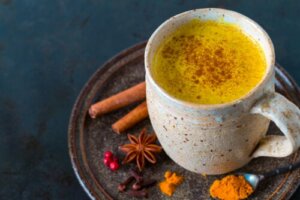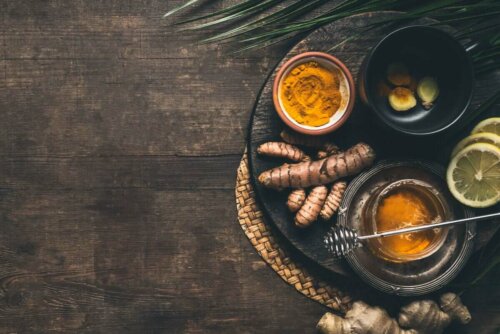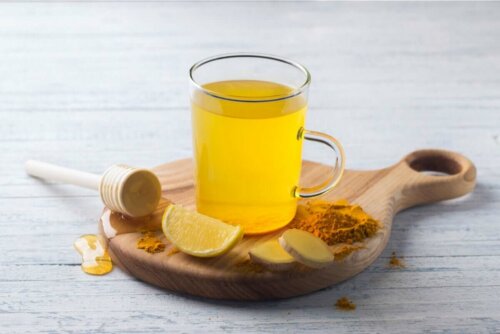Five Benefits of Drinking a Turmeric Tisane

There are many health benefits in a cup of turmeric tisane (herbal tea) as it’s the rhizome of an herb of the Zingiberaceae family — ginger and cardamom also belong to it. Its popularity has skyrocketed in recent years as many people swear by its anti-inflammatory and antioxidant properties.
You’ve surely seen this root around and perhaps due to its characteristic orange color you’ve wondered what it’s for. So today we’d like to tell you more about its properties and how to brew a tisane with it to enjoy its full potential.
The benefits of drinking a turmeric tisane
There are many benefits attributed to turmeric due to its antioxidant and anti-inflammatory properties. One of the most popular ways to consume it is as a tisane. This is because it’s a great way to enjoy its characteristic flavor and benefit from its medicinal properties.
1. Helps with arthritis symptoms
Curcumin, the active ingredient of turmeric, is a substance known to have antioxidant effects. Research in humans is still in its early stages but apparently, there’s evidence at the molecular level that could support its effects.
This is the case of a study published in Springer Plus, which indicates this element could be effective in the reduction of pain in patients with osteoarthritis. This condition occurs when the cartilage that cushions the joints gradually deteriorates, leading to bone damage.

Find out more: How to Improve Blood Circulation with Turmeric
2. It may help prevent Alzheimer’s
The specific cause of this disease isn’t fully known yet but a publication from the Alzheimer’s Research Center suggests that curcumin would reduce the loss of synaptic markers and the accumulation of amyloid. This is because both are related to the development of this pathology.
3. A cup of turmeric tisane can stimulate the immune system
Another health benefit of this infusion is it seems to boost the immune system. In fact, a review published in the Journal of Clinical Immunology suggests its consumption might have positive results in the treatment of autoimmune disorders.
4. It helps with cholesterol circulation
Cholesterol is a necessary substance for the body to form healthy cells. However, high amounts of it in the blood increase the risk of it forming deposits in the blood vessels. Thus, it leads to some serious conditions, such as heart disease and stroke.
According to a study published in Nutrition Journal, turmeric and curcumin were effective in reducing the risk of cardiovascular diseases, thanks to their cardioprotective properties. In addition, its consumption helped reduce cholesterol and triglyceride levels in high-risk patients with this condition.
5. It’s helpful in the treatment of uveitis
Uveitis happens when there’s swelling and redness in the middle layer of the eyeball. Its main cause is unknown, although it seems that some factors such as the presence of certain viruses or suffering from inflammatory diseases could have an impact on its development.
Curcumin has been used for years to treat various diseases, including inflammatory ones. Regarding uveitis, research published in Clinical Ophthalmology states this component of turmeric could be a therapy adjunct with which to improve this condition.
Learn how to make Five Impressive Anti-inflammatory Remedies with Turmeric
How to brew a turmeric tisane
You’ll only need water and turmeric to make this simple drink at home and enjoy its aforementioned benefits. Just follow the steps below.
Ingredients
- 2 c. of water
- 1 tsp of turmeric
- Honey (optional)
- Ginger (optional)
Preparation
- Firstly, pour the water into a pot and boil it on high heat
- Then, lower the heat to medium-low, add the turmeric and stir well – add some ginger if you want to add extra properties and flavor to the drink
- Cook over a low heat for about 5 to 10 minutes
- Then, strain the tea into the cup of your choice
- Finally, you may sweeten it with honey and enjoy it

Possible side effects of drinking a turmeric tisane
Generally, the consumption of turmeric is safe, although side effects may occur if ingested in large amounts. In fact, a publication by the Specialist Pharmacy Center points out that the most common signs of poisoning could include:
- Constipation, dyspepsia, and diarrhea
- Bloating and stomach pain
- Gastroesophageal reflux with nausea
- Yellow stools
Finally, the benefits of turmeric shouldn’t replace medical treatment for any of the health conditions mentioned above. So, consult your doctor if you have any questions about its consumption.
All cited sources were thoroughly reviewed by our team to ensure their quality, reliability, currency, and validity. The bibliography of this article was considered reliable and of academic or scientific accuracy.
- Allegri, P., Mastromarino, A., & Neri, P. (2010). Management of chronic anterior uveitis relapses: efficacy of oral phospholipidic curcumin treatment. Long-term follow-up. Clinical ophthalmology (Auckland, N.Z.), 4, 1201–1206. https://doi.org/10.2147/OPTH.S13271
-
Jagetia GC, Aggarwal BB. “Spicing up” of the immune system by curcumin. J Clin Immunol. 2007;27(1):19-35. doi:10.1007/s10875-006-9066-7
- Henrotin, Y., Priem, F., & Mobasheri, A. (2013). Curcumin: a new paradigm and therapeutic opportunity for the treatment of osteoarthritis: curcumin for osteoarthritis management. SpringerPlus, 2(1), 56. https://doi.org/10.1186/2193-1801-2-56
- Marmitt, Diorge Jônatas, et al. “Revisión sistemática de las plantas de interés para el Sistema de Salud con potencial terapéutico cardiovascular.” Revista Cubana de Plantas Medicinales 21.1 (2016): 108-124.
- Freire-González, Rosa A., and Marlén Vistel-Vigo. “Caracterización fitoquímica de la Curcuma longa L.” Revista Cubana de Química 27.1 (2015): 9-18.
- Chacín, Yemina Josefina Figuera, et al. “Constituyentes químicos de las hierbas y especias: Efectos sobre la salud humana.” Revista Científica UDO Agrícola 13.1 (2013): 1-16.
This text is provided for informational purposes only and does not replace consultation with a professional. If in doubt, consult your specialist.








